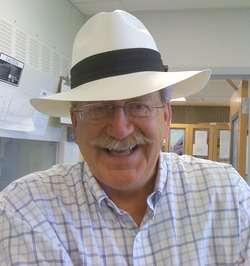John Roth (geneticist)
| John R. Roth | |
|---|---|
|
John R. Roth | |
| Born |
March 14, 1939 Winona, Minnesota |
| Nationality | American |
| Fields | Genetics |
| Institutions |
University of California, Berkeley University of Utah University of California, Davis |
| Alma mater |
Harvard University (BA) Johns Hopkins University (PhD) Umeå University (PhD Honoris Causa) |
| Doctoral advisor | Phil Hartman |
| Notable awards |
Genetics Society of America Thomas Hunt Morgan Medal (2009) [1] |
| Spouse | Shery G. Roth |
John R. Roth[2] is an American geneticist, bacterial physiologist, and evolutionist. He is a Distinguished Professor of Biological Sciences at the University of California, Davis.
He became well known for his early studies on the structure and regulation of the his operon of Salmonella,[3] and went on to investigate regulation in systems as diverse as suppression by tRNA,[4] NAD biosynthesis,[5] and the Vitamin B12-dependent metabolism of small molecules such as ethanolamine and propanediol.[6] In collaboration with David Botstein and Nancy Kleckner, he developed the use of transposons as genetic tools.[7] As a by-product of his study of transposons, he developed an interest in chromosomal duplications, which are frequent in bacteria.[8] He has recently authored several papers on the involvement of such small-effect mutations on evolution under selection.[9]
As instructors of the summer Advanced Bacterial Genetics course at Cold Spring Harbor Laboratory, John Roth, David Botstein, and Ron Davis taught many scientists how to use transposons and other modern molecular genetic tools for analysis of bacteria, leading to important advances in our understanding of the genetics and physiology of bacteria.[2]
In 1988, he became a member of the National Academy of Sciences,.[10] In 2009, he was awarded the Thomas Hunt Morgan Medal of the Genetics Society of America.,[1] and in 2015, the American Society for Microbiology Lifetime Achievement Award. In 2011, ASM Press published a festschrift in his honor ("The Lure of Bacterial Genetics: A Tribute to John Roth").[2]
References
- 1 2 Thomas Hunt Morgan Medal
- 1 2 3 Maloy, S., Hughes, K.T. & Casadesus, J., eds. (2011). The Lure of Bacterial Genetics: A Tribute to John Roth. Washington, DC: ASM Press. p. 362. ISBN 978-1-55581-538-7.
- ↑ Johnston, M., Barnes, W., Chumley, F., Bossi, L. & Roth, J.R. (1980). "Model for regulation of the histidine operon of Salmonella". Proc. Natl. Acad. Sci. USA. 77: 508–512.
- ↑ Hartman, P. & Roth, J.R. (1973). "Mechanisms of suppression". Adv.Genet. 17: 1–105.
- ↑ Zhu, N. & Roth, J.R. (1991). "The nadI region of Salmonella typhimurium encodes a bifunctional regulatory protein". J.Bacteriol. 173: 1302–1310.
- ↑ Roof, D.M. & Roth, J.R. (1992). "Autogenous regulation of ethanolamine utilization by a transcriptional activator of the eut operon in Salmonella typhimurium". J.Bacteriol. 174: 6634–6643.
- ↑ Kleckner, N., Botstein, D. & Roth, J.R. (1977). "Genetic engineering in vivo using translocatable drug-resistance elements. New methods in bacterial genetics". J.Mol.Biol. 116: 125–159. doi:10.1016/0022-2836(77)90123-1.
- ↑ Roth, J.R., Benson, N., Galitski, T., Haack, K., Lawrence, J. & Miesel, L. (1996). "Rearrangements of the bacterial chromosome: formation and applications". In Neidhardt, F.C., Curtis, R., III, Ingraham, J.L., Lin, E.C.C., Low, K.B., Magasanik, B., Reznikoff, W.S., Riley, M., Schaechter, M. & Umbarger, H.E. Escherichia coli and Salmonella: Cellular and Molecular Biology. Washington, DC: ASM Press. pp. 2256–2276. ISBN 1-55581-084-5.
- ↑ Andersson, D.I., Hughes, D. & Roth, J.R. (2011). "The origin of mutants under selection: interactions of mutation, growth, and selection, Chapter 5.6.6". In Finkel, S. EcoSal -- Escherichia coli and Salmonella: Cellular and Molecular Biology. 10.1128. Washington, DC: ASM Press.PDF
- ↑ Members' Directory
